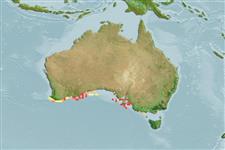Actinopterygii (ray-finned fishes) >
Perciformes (Perch-likes) >
Odacidae (Cales and weed-whitings)
Etymology: Siphonognathus: Greek, siphon = tube + Greek, gnathos = jaw (Ref. 45335).
Environment / Climate / Range
Ecology
Marine; demersal; depth range 1 - 19 m (Ref. 75154). Subtropical, preferred ?; 32°S - 39°S
Eastern Indian Ocean: southern Australia, from Recherche Archipelago, Western Australia to Wilsons Promontory and Portland, Victoria.
Size / Weight / Age
Maturity: Lm ? range ? - ? cm
Max length : 11.0 cm SL male/unsexed; (Ref. 6185)
A benthic species which occurs inshore (Ref. 75154). Apparently restricted to moderately high-energy coastal locations with dominant stands of brown macroalgae such as Phyllospora comosa and Ecklonia radiata.
Life cycle and mating behavior
Maturity | Reproduction | Spawning | Eggs | Fecundity | Larvae
Gomon, M.F. and J.R. Paxton, 1985. A revision of the Odacidae, a temperate Australian-New Zealand labroid fish family. Indo-Pac. Fish. (8):57 p. (Ref. 6185)
IUCN Red List Status (Ref. 115185)
CITES (Ref. 94142)
Not Evaluated
Threat to humans
Harmless
Human uses
Fisheries: of no interest
More information
Common namesSynonymsMetabolismPredatorsEcotoxicologyReproductionMaturitySpawningFecundityEggsEgg development
Age/Size
Growth
Length-weight
Length-length
Length-frequencies
Morphometrics
Morphology
Larvae
Larval dynamics
Recruitment
Abundance
ReferencesAquacultureAquaculture profileStrainsGeneticsAllele frequenciesHeritabilityDiseasesProcessingMass conversion
Tools
Special reports
Download XML
Internet sources
Estimates of some properties based on models
Phylogenetic diversity index (Ref.
82805): PD
50 = 0.5159 [Uniqueness, from 0.5 = low to 2.0 = high].
Bayesian length-weight: a=0.00389 (0.00180 - 0.00842), b=3.12 (2.94 - 3.30), in cm Total Length, based on all LWR estimates for this body shape (Ref.
93245).
Trophic Level (Ref.
69278): 2.8 ±0.2 se; Based on size and trophs of closest relatives
Resilience (Ref.
69278): High, minimum population doubling time less than 15 months (Preliminary K or Fecundity.).
Vulnerability (Ref.
59153): Low vulnerability (12 of 100) .
